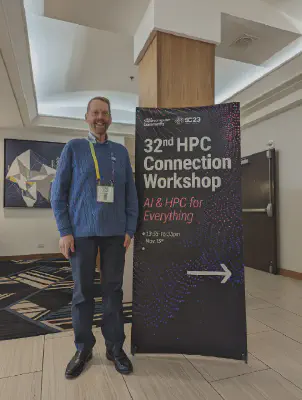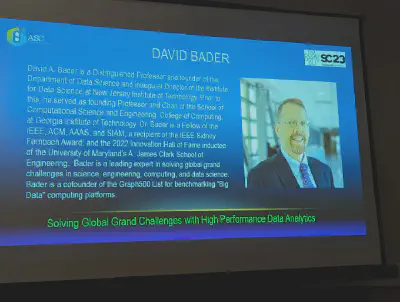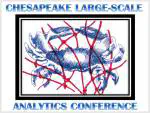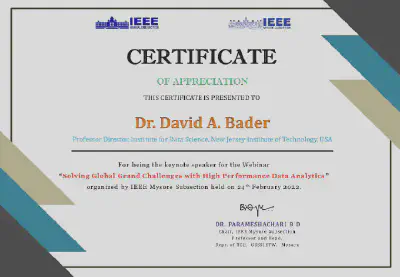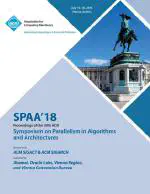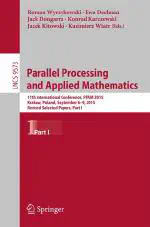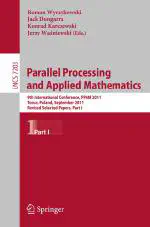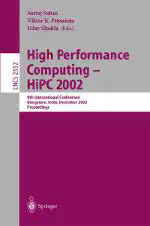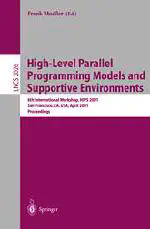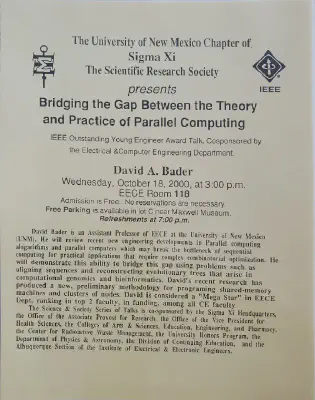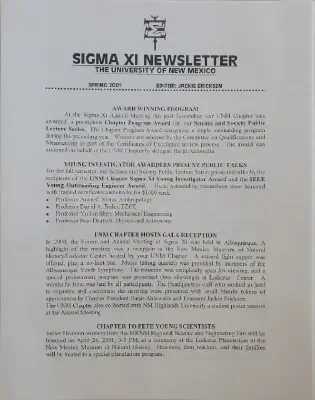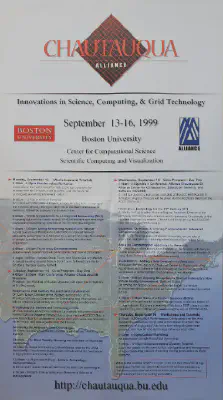Recent & Upcoming Talks
Session Topics
- Is academia for me?
- How do I land an academic position?
About of Featured Guests:
- David Bader (ECE Ph.D. ‘96), Professor, New Jersey Institute of Technology
- Chai-Wai Wong (ECE Ph.D. ‘17), Associate Professor, NC State University
Local Panelists:
- Prof. Sanghamitra Dutta
- Prof. Carol Espy-Wilson
- Prof. Jesse Moody
- Prof. Thomas Murphy
- Prof. Kaiqing Zhang
Moderator:
- Prof. Cheng Gong
Please register at https://go.umd.edu/ECEGSA-AcademicPanel2025
Event counts as one ECE Colloquium Series attendance
Event organizers: Irem Didin, Sydney Overton and Solaleh Mohammadi
A real-world challenge in data science is to develop interactive methods for quickly analyzing new and novel data sets that are potentially of massive scale. In this talk, Bader will discuss his development of graph algorithms in the context of Arkouda, an open-source NumPy-like replacement for interactive data science on tens of terabytes of data. Massive-scale analytics is an emerging field that integrates the power of high-performance computing and mathematical modeling to extract key insights and information from large-scale data sets. Productivity in massive-scale analytics entails quick interpretation of results through easy-to-use frameworks, while also adhering to design principles that combine high-performance computing and user-friendly simplicity. However, data scientists often encounter challenges, especially with graph analytics, which require the analysis of complex data from various domains, such as the cybersecurity, natural and social sciences. To address this issue, we introduce Arachne, an open-source framework that enhances accessibility and usability in massive-scale graph analytics. Arachne offers novel algorithms and implementations of graph kernels for efficient data analysis, such as connected components, breadth-first search, triangle counting, k-truss, among others. The high-performance algorithms are integrated into a back-end server written in HPE/Cray’s Chapel language and can be accessed through a Python application programming interface (API). Arachne’s back-end server is compatible with Linux supercomputers, is easy to set up, and can be utilized through either Python scripts or Jupyter notebooks, which makes it a desirable tool for data scientists who have access to high performance computers. In this talk, Bader presents an overview of the algorithms his research group has implemented into Arachne and, if applicable, the algorithmic innovations of each. Further, Bader will discuss improvements to our graph data structure to store extra information such as node labels, edge relationships, and node and edge properties. Arachne is built as an extension to the open-source Arkouda framework and allows for graphs to be generated from Arkouda dataframes. The open-source code for Arachne can be found at https://github.com/Bears-R-Us/arkouda-njit. This is joint work with Oliver Alvarado Rodriguez, Zhihui Du, Joseph Patchett, Naren Khatwani, Fuhuan Li, Bader is supported in part by the National Science Foundation award CCF-2109988.

Meet the speaker for the event, 𝗦𝗼𝗹𝘃𝗶𝗻𝗴 𝗚𝗹𝗼𝗯𝗮𝗹 𝗚𝗿𝗮𝗻𝗱 𝗖𝗵𝗮𝗹𝗹𝗲𝗻𝗴𝗲𝘀 𝘄𝗶𝘁𝗵 𝗛𝗶𝗴𝗵-𝗣𝗲𝗿𝗳𝗼𝗿𝗺𝗮𝗻𝗰𝗲 𝗗𝗮𝘁𝗮 𝗔𝗻𝗮𝗹𝘆𝘁𝗶𝗰𝘀, A distinguished Professor and Director, 𝗗𝗿. 𝗗𝗮𝘃𝗶𝗱 𝗔. 𝗕𝗮𝗱𝗲𝗿. David A. Bader is a Professor in the Department of Computer Science and founder of the Department of Data Science and inaugural Director of the 𝗜𝗻𝘀𝘁𝗶𝘁𝘂𝘁𝗲 𝗳𝗼𝗿 𝗗𝗮𝘁𝗮 𝗦𝗰𝗶𝗲𝗻𝗰𝗲 at 𝗡𝗲𝘄 𝗝𝗲𝗿𝘀𝗲𝘆 𝗜𝗻𝘀𝘁𝗶𝘁𝘂𝘁𝗲 𝗼𝗳 𝗧𝗲𝗰𝗵𝗻𝗼𝗹𝗼𝗴𝘆. Dr. Bader is also a Fellow of the 𝗜𝗘𝗘𝗘, 𝗔𝗔𝗔𝗦, and 𝗦𝗜𝗔𝗠, and received the 𝗜𝗘𝗘𝗘 𝗖𝗦 𝗦𝗶𝗱𝗻𝗲𝘆 𝗙𝗲𝗿𝗻𝗯𝗮𝗰𝗵 𝗔𝘄𝗮𝗿𝗱 and the best paper awards from 𝗜𝗦𝗖, 𝗜𝗘𝗘𝗘 𝗛𝗣𝗘𝗖, 𝗮𝗻𝗱 𝗜𝗘𝗘𝗘/𝗔𝗖𝗠 𝗦𝗖. His interests are at the intersection of high-performance computing and real-world applications, including cybersecurity, massive-scale analytics, and computational genomics. Dr. Bader has also served as a lead scientist in several 𝗗𝗔𝗥𝗣𝗔 𝗽𝗿𝗼𝗴𝗿𝗮𝗺𝘀 and has received awards like 𝗡𝗩𝗜𝗗𝗜𝗔 𝗔𝗜 𝗟𝗮𝗯 (𝗡𝗩𝗔𝗜𝗟) and 𝗙𝗮𝗰𝗲𝗯𝗼𝗼𝗸 𝗥𝗲𝘀𝗲𝗮𝗿𝗰𝗵 𝗔𝗜 𝗛𝗮𝗿𝗱𝘄𝗮𝗿𝗲/𝗦𝗼𝗳𝘁𝘄𝗮𝗿𝗲 𝗖𝗼-𝗗𝗲𝘀𝗶𝗴𝗻 𝗮𝘄𝗮𝗿𝗱. Dr. Bader is 𝗘𝗱𝗶𝘁𝗼𝗿-𝗶𝗻-𝗖𝗵𝗶𝗲𝗳 of the 𝗔𝗖𝗠 𝗧𝗿𝗮𝗻𝘀. on Parallel Computing, and previously served as 𝗘𝗜𝗖 𝗼𝗳 𝘁𝗵𝗲 𝗜𝗘𝗘𝗘 𝗧𝗿𝗮𝗻𝘀. on Parallel and Distributed Systems. Read more about him here: (https://lnkd.in/drtzsT_r)
https://web.archive.org/web/19991126000736/http://chautauqua.ahpcc.unm.edu/
CLUSTERS - The Most Rapidly Growing Architecture of High-End Computing
Dr. David A. Bader, University of New Mexico, and lead for the UNM Roadrunner Linux-based Supercluster, will talk about the “next wave” in high performance computing.






















